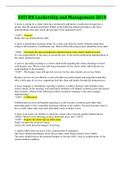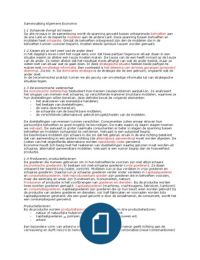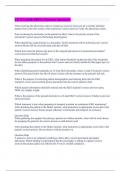RESPIRATION
18.1 GLYCOLYSIS
CELLULAR RESPIRATION
Glucose- hexose sugar produced in photosynthesis/ contains energy
absorbed from sunlight within its carbon-hydrogen bonds
-when bonds broken, energy is released which is used in ATP synthesis by
chemiosmosis.
Respiration- complex multi-step reaction pathway- releases energy to make
ATP
-occurs similarly in eukaryotes to prokaryotes except that prokaryotes have no
mitochondria so reactions happen on cell membranes
GLYCOLYSIS: (occurs in both aerobic and anaerobic)
-occurs in the cytoplasm of the cell- because glucose molecule too big to enter
mitochondria
-Glucose split into 2 smaller 3-carbon pyruvate molecules
, 1.PHOSPHORYLATION: 2 ATP molecules needed - 1 phosphate released from each of
these to form 2 ADP. phosphates attach to glucose to form hexose bisphosphate
2.LYSIS: molecule is unstable causing it to split to form 2 triose phosphate molecules
3.PHOSPHORYLATION: another phosphate added to each triose phosphate to form 2 triose
bisphosphate molecules. (phosphates come from free inorganic phosphate ions in cytoplasm
4.DEHYDROGENATION: the 2 triose bisphosphate molecules then oxidised by removal of
hydrogen atoms to form 2 pyruvate molecules. NAD enzymes accept these hydrogens-
become reduced forming 2 reduced NAD molecules.
- 4ADP molecules gain a phosphate each to form 4 ATP molecules - this is an
example of substrate level of phosphorylation- formation of ATP without involvement
of electron transport chain or ATP synthase
-2 ATP molecules used at beginning but 4 formed in the end= net yield is 2 ATP molecules
PRODUCTS OF GLYCOLYSIS:
-2x pyruvate
-net gain 2 ATP
-2x reduced NAD
18.2 LINK REACTION:
-Link reaction occurs in the matrix- pyruvate molecules small enough to enter mitochondria
1. Pyruvate enters the mitochondrial matrix by active transport via specific carrier
proteins.
2. Pyruvate then undergoes oxidative decarboxylation (CO2 removed) and
dehydrogenation
3. Co-enzyme NAD is reduced to form NADH (accepts H atoms)
4. Forms 2-carbon acetyl group which binds to coenzyme A forming acetyl coenzyme A
(acetyl CoA)
5. Acetyl CoA delivers acetyl group to next stage of aerobic respiration (krebs cycle).
-Reduced NAD will be used in oxidative phosphorylation to synthesise ATP.
18.1 GLYCOLYSIS
CELLULAR RESPIRATION
Glucose- hexose sugar produced in photosynthesis/ contains energy
absorbed from sunlight within its carbon-hydrogen bonds
-when bonds broken, energy is released which is used in ATP synthesis by
chemiosmosis.
Respiration- complex multi-step reaction pathway- releases energy to make
ATP
-occurs similarly in eukaryotes to prokaryotes except that prokaryotes have no
mitochondria so reactions happen on cell membranes
GLYCOLYSIS: (occurs in both aerobic and anaerobic)
-occurs in the cytoplasm of the cell- because glucose molecule too big to enter
mitochondria
-Glucose split into 2 smaller 3-carbon pyruvate molecules
, 1.PHOSPHORYLATION: 2 ATP molecules needed - 1 phosphate released from each of
these to form 2 ADP. phosphates attach to glucose to form hexose bisphosphate
2.LYSIS: molecule is unstable causing it to split to form 2 triose phosphate molecules
3.PHOSPHORYLATION: another phosphate added to each triose phosphate to form 2 triose
bisphosphate molecules. (phosphates come from free inorganic phosphate ions in cytoplasm
4.DEHYDROGENATION: the 2 triose bisphosphate molecules then oxidised by removal of
hydrogen atoms to form 2 pyruvate molecules. NAD enzymes accept these hydrogens-
become reduced forming 2 reduced NAD molecules.
- 4ADP molecules gain a phosphate each to form 4 ATP molecules - this is an
example of substrate level of phosphorylation- formation of ATP without involvement
of electron transport chain or ATP synthase
-2 ATP molecules used at beginning but 4 formed in the end= net yield is 2 ATP molecules
PRODUCTS OF GLYCOLYSIS:
-2x pyruvate
-net gain 2 ATP
-2x reduced NAD
18.2 LINK REACTION:
-Link reaction occurs in the matrix- pyruvate molecules small enough to enter mitochondria
1. Pyruvate enters the mitochondrial matrix by active transport via specific carrier
proteins.
2. Pyruvate then undergoes oxidative decarboxylation (CO2 removed) and
dehydrogenation
3. Co-enzyme NAD is reduced to form NADH (accepts H atoms)
4. Forms 2-carbon acetyl group which binds to coenzyme A forming acetyl coenzyme A
(acetyl CoA)
5. Acetyl CoA delivers acetyl group to next stage of aerobic respiration (krebs cycle).
-Reduced NAD will be used in oxidative phosphorylation to synthesise ATP.










